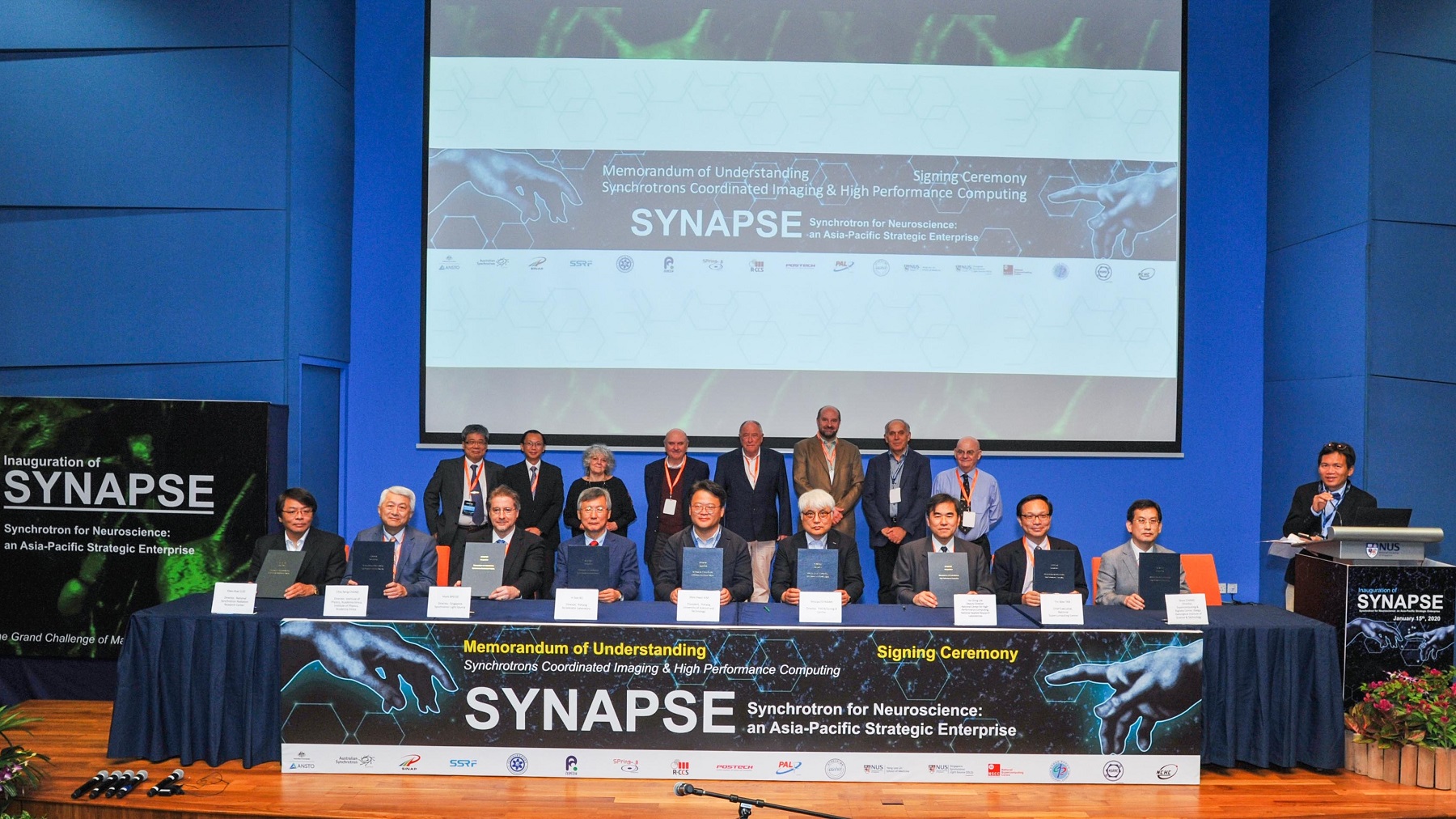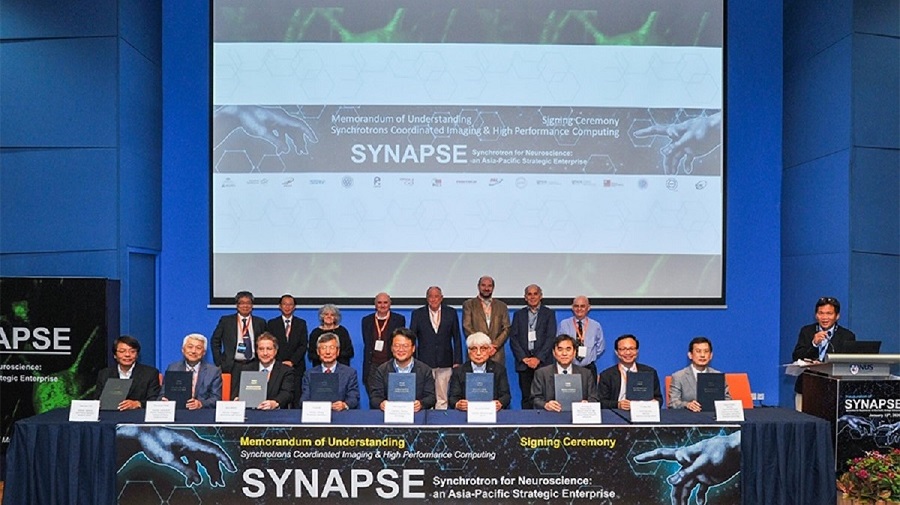Asia Pacific Scientists Join Hands to Map the Neuronal Network of the Entire Human Brain: SYNAPSE Opens in Singapore
News release from the Ministry of Science and Technology (Department of Natural Sciences and Sustainable Development. Contact person: Xu Ai-jia, assistant research fellow)
SYNAPSE (Synchrotrons for Neuroscience – An Asia Pacific Strategic Enterprise) was founded at the suggestion of Taiwanese scientists. Its objective is to, in three years, use ultra-high resolution X-ray 3D imaging technology and ultra-large supercomputers to draw, in ultra-high resolutions, the first map of the neuronal network of the entire human brain. Hu Yu-guang, the key figure of SYNAPSE, is a special research fellow at the Institute of Physics of Academia Sinica. Under the long-term support of the Science Vanguard Research Program of the Department of Natural Sciences and Sustainable Development, Ministry of Science and Technology, Academia Sinica, and National Synchrotron Radiation Research Center, Hu has actively promoted international collaborations, including this signing of the SYNAPSE plan at the National University of Singapore. Currently the collaboration alliance has evolved into an international research network of several hundred scientists from strong research organizations in synchrotron light source, neuroscience, computational science, physics, chemistry, and engineering from Singapore, Australia, China, Japan, Korea, and Taiwan.
Hu Yu-guang and Professor Jiang An-shi of National Tsing Hua University will lead the Taiwanese research team that encompasses the advanced synchrotron light source of the National Synchrotron Radiation Research Center (NSRRC), the NCHC, and other research organizations. Based on their longtime research experience and accomplishments, they will be responsible for the capturing, processing, work coordination, and information management of images–the most important tasks in the building of the neuronal networks of the entire human brain and the entire mouse brain. The SYNPSE alliance will be officially founded today on Jan. 15, 2020 in Singapore. All founding members will sign their first research memorandum of understanding, which will vow to strive to lead the world in completing by 2023 the world's first map of the neuron network of an entire human brain with high enough a resolution to reveal the connections at the sub-cellular level.
Using powerful 3D X-ray technology to form the images of the neuron network of an entire human brain at the sub-cellular level coupled with the computations of a supercomputer, SYNAPSE plans to complete within three years the first 3D map of the neuron network of an entire human brain. With the completion of the maps of neuron networks of other lab animals, this huge database will help advance the research and effective treatments of perplexing diseases of the brain. The newly developed images and computational techniques will also help guide new strategies and research directions for biomedical imaging and advanced ultra-huge computation.
Each participating synchrotron radiation facility of this alliance will be responsible for photographing the images of certain areas of the brain. Under the identical X-ray conditions provided by synchrotrons, the team will take images at a speed of 1 cubic millimeter and at a resolution of 0.3 micrometer. The captured 3D images will be handed over to the computational center to draw the map of the neuron network. The 3D X-ray technology can capture and process images more than 10 to 100 times faster than other currently available 3D image capturing techniques with a similar resolution, such as super-resolution microscopy or electron microscopy. Professor Hu Yu-guang estimated that it would take about four years for the SYNAPSE team to draw the first map of the neuronal network of the entire human brain and its connections. If other techniques are used, the map may never be completed in our lifetime.
Not only use X-ray tomography to scan the neuronal network and its connections of the entire human brain, but the SYNAPSE team will also use, for example, X-ray nanotomography, infrared micro-spectroscopy, super-resolution visible light 3D microscopy, cryogenic electron tomography, and such advanced biomedical imaging techniques to conduct in-depth study of select areas of the brain. Integrating all these techniques will provide super-minute structural details of the brain that can be, like in Google Earth, continuously enlarged to allow detailed studies and analyses of the entire neuronal network.
The process of positioning in a human brain generates huge amounts of research data. Therefore, the SYNAPSE members will sign together today their second research memorandum of understanding: to jointly establish a high-efficiency computing network to effectively process, collect, share, and analyze all data. With its advanced computational capabilities, the NCHC is one of the key organizations that will supply SYNAPSE with a data network. The NCHC will use the most advanced high-performance computer and high-speed international networks to participate in the SYNAPSE collaboration.
The SYNAPSE team will advance our understanding of the structure of a human brain and the composition of its various structures, which will shine light on the normal functioning and the cause of diseases of a human brain. Professor Chian-Ming Low of the National University of Singapore, one of the founders of this alliance, said, “Because diseases in the brain are exerting a bigger and bigger influence on health care around the world, the mapping of the neuronal network of the brain must proceed as quickly as possible. The SYNAPSE alliance will use unprecedented speed of image capturing, resolution, and analytical capabilities to face the challenges of mapping the neuronal network of the entire human brain. The huge map of the neuronal network of a human brain that this project will generate will be used to help us understand how neurons connect and how they interact and how these diseases affect cognition and intelligence. Our findings may be helpful in the treatment of important neuro-degenerative diseases, such as Alzheimer's disease and other dementia.” His remarks best illustrate the importance of this alliance for medical treatment and health maintenance.
In addition to the direct participation of scientists from Asia Pacific, this alliance has also invited scientists from other advanced countries to form an advisory committee in the hope that they, through their preeminence and international prestige in neuropathology, electrophysiology, cell biology, and radiology, would support the research directions of SYNAPES plans and help ensure that these directions are scientifically superior.
Nobel laureates Professors Kurt Wüthrichand Ada Yonath were also invited to grace the signing of the two SYNAPES research memoranda of understanding and the official beginning of research collaborations. They also shared with the attendants their thoughts on the SYNAPSE plans and the necessity of international collaborations on synchrotron research.

SYNAPSE leaders of important scientific organizations in Asia Pacific pose for photos in Singapore.
Since 2003, the research team in Taiwan has received long-term support from the Nano National-Level Projects and the Science Vanguard Research Program of National Science Council and the Ministry of Science and Technology and the Forward-looking Research Center of Professor Jiang An-shi. Additionally, the Ministry of Science and Technology has independently and continuously provided funding for the building of dedicated beamline for brain imaging at the newly built Taiwan Phanton Source (TPS). Before the application targets of our research became totally visible, the Ministry of Science and Technology provided steady and sizable support for our basic research. This support has enabled the research team to conduct basic research on X-ray imaging. The team then used its unique research results to develop the technology for 3D X-ray microscopy for biological systems. The team has accumulated sufficient technical superiority to finally prove that its techniques are functionally sufficient to breakthrough the bottlenecks in image resolution and image formation speed of the brain. Its capabilities have enticed other synchrotrons to put aside their basic mission in scientific competition and instead, while taking on only minimal risks, to collaborate toward a single scientific goal.
 國家高速網路與計算中心
國家高速網路與計算中心
